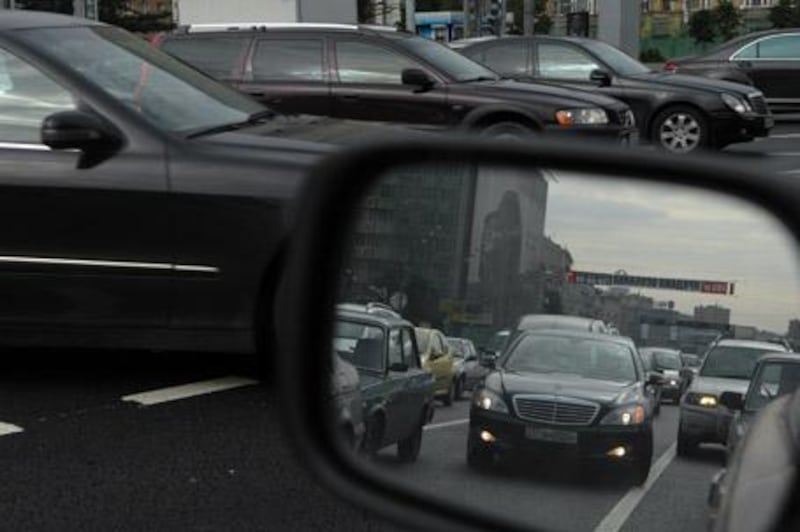MOSCOW // Rush-hour gridlock in the Russian capital is largely predictable. In the morning, inbound commuter traffic chokes the city's main arteries, while outbound traffic is sparse on the other side. In the evening vice versa. To avoid the snarling congestion, the more brazen Moscow drivers - many of them bureaucrats in expensive cars equipped with whining blue sirens - will buzz down the central reserved lane flouting the law while idling drivers look on and seethe.
Olga Alexandrina, a Moscow obstetrician-gynecologist, was a cautious driver, her friends and family say. And traffic was light on the morning of February 25 as she was driving to work in an outbound lane on the expansive Leninsky Prospekt in southern Moscow: there would have been little reason for her to take to the median strip. It remains uncertain exactly how the Citroën C3 hatchback driven by Alexandrina, 35, collided head-on with an oncoming Mercedes carrying a senior oil executive, killing her and her mother-in-law. But the tragedy has elicited fury nationwide over the impunity with which Russia's rich and powerful rule the roads.
Alexandrina's car was demolished in the collision with the Mercedes S-500 sedan carrying Anatoly Barkov, the vice president of Lukoil, Russia's largest oil company. She died at the scene, while her mother-in-law, Vera Sidelnikova, 72, died of her injuries in the hospital. Mr Barkov, 62, and his driver both survived with minor injuries, and a traffic police officer said in televised comments from the scene of the accident that Alexandrina had been driving too fast and swerved into the median strip after losing control of her vehicle.
Almost immediately, however, witnesses and the Russian blogosphere began challenging this version of events. A driver who said he saw the accident told a morning call-in radio show said the Mercedes had been speeding down the median and slammed into the red Citroën. Bloggers and car owner lobbies said traffic patterns and the driving habits of Russia's elite suggest Mr Barkov may have been driving on the median to circumvent inbound gridlock.
Fuelling speculation about a possible cover-up were contradictory reports about surveillance cameras that may have captured footage of the crash. Igor Trunov, a prominent lawyer representing the victims' family, complained that police were refusing him access to possible video footage of the accident. Then the state-run RIA-Novosti news agency cited a law enforcement source as saying a potential suspect in the disappearance of the footage had been identified and that authorities were investigating.
Finally, on Friday, Moscow traffic police released footage that proved inconclusive because of a billboard blocking the camera's view of the accident site. Mr Barkov's car can be seen hugging the centre line in the far left lane, but it disappears behind the billboard. There did not appear to be a traffic jam on either side of the freeway, according to the footage. "We can only see what happened 200 metres before the accident," the Moscow traffic police chief, Sergei Kazantsev, said during a news conference, RIA-Novosti reported.
Police have not yet established who was at fault, Alexei Kuznetsov, a senior Moscow police investigator, told reporters. Mr Barkov released a statement to the Russian media last week expressing his condolences to the victims' families and saying he wants a thorough investigation of the accident. The tragedy would have probably gone unnoticed in Russia, where between 25,000 and 30,000 people die annually in road accidents, had it not involved a senior executive. Numerous deadly car accidents involving well-connected Russians have sparked grassroots outrage in recent years, and the ubiquitous sight of the powerful using their status to wantonly violate traffic rules has become a notorious symbol of social stratification.
In 2005, the son of Sergei Ivanov, then the Russian defence minister, slammed his car into an elderly female pedestrian in southern Moscow, killing her almost instantly. Prosecutors eventually ruled that the minister's son, Alexander Ivanov, was not at fault, prompting accusations from government critics that the minister had pulled strings to clear his son. Mr Ivanov, who is now a deputy prime minister, denied those allegations.
In 2006, Russian drivers held rallies nationwide in defence of a driver convicted in a car crash that killed Mikhail Yevdokimov, the governor of Russia's Altai region. The driver, Oleg Shcherbinsky, later had the conviction overturned in what was seen as the authorities' acquiescence to the country's enraged car owner lobbies, whose fanatical devotion to their vehicles has made it one of the few of Russia's grassroots organisations capable of influencing government policy.
Sergei Kanayev, the head of the Moscow branch of the Federation of Russian Car Owners, said his group has located several witnesses whose independent accounts suggest that Mr Barkov's car was driving illegally down the median strip when it collided with Alexandrina's Citroën. He said his group would provide the results of its independent inquiry in which it did not have access to the cars just the photographs to prosecutors and hope for a fair investigation. Alexandrina may indeed have been at fault in the crash, Mr Kanayev said, but the outpouring of anger among Russians shows the depth of their antipathy towards the elite's well-known disregard for road rules.
"It's characteristic of the attitude of the powerful towards regular citizens," Mr Kanayev said. "Everyone was already dismayed with the situation. This was just the last straw." cschreck@thenational.ae






